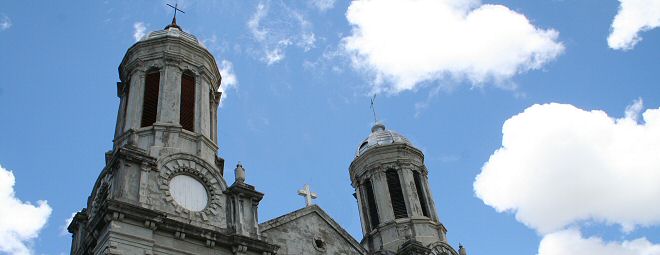"A BUILDING WITHIN A BUILDING"
Two St. John's Anglican Churches have already stood on the site of the present cathedral. The first was built of wood as early as 1681 and was said to be "totally destitute of beauty or comfort". The second was constructed with English brick about 1720 when the first fell in disrepair and became too small.
The church was designed by Mr. Robert Cullen and had a short steeple at its western end. After over a century, the church was elevated to the status of a cathedral when the Diocese of Antigua was created in August 1842.
As plans were being made to make the church worthy of its new status, a violent earthquake severely damaged it in February 1843. Temporary repairs were made and in it Bishop Daniel Davis was enthroned as the first Bishop of Antigua.
Next to the site of the first two churches a new purpose built cathedral was planned and approved by the House of Assembly. The Governor, Sir Charles Augustus Fitzroy, laid the cornerstone on October 9, 1843 and on October 10 three years later, the Cathedral was opened for divine service. It was consecrated on July 25, 1848.
The Cathedral is built of freestone and the architect was Mr. J. Fuller of Bath and the Clerk of Works was Mr. F.W. Rowe of Bristol. The interior is encased in pitch pine, intending to secure the building from ruin during earthquake or hurricane. It has been described as "a building within a building".
The Cathedral is dominated by twin towers at the west end and provides a distinct baroque flavour. They are 70 ft high and the cupolas that crown the towers are aluminium in colour. At the time of erection, the edifice was criticised by ecclesiastical architects as being like "a pagan temple with two dumpy pepper pot towers", however in modern times the edifice has been cited as "the most imposing of all the Cathedrals of the West Indian Province".
Originally the south gate was the main entrance to the Cathedral. On top of its pillars are the bronze figures of St. John the Divine and St. John the Baptist. H.M.S. Temple is said to have taken these figures from a French ship destined for Martinique in 1756 during the Seven Years War. The iron gates themselves date from 1789.
A centenarian, Samuel Smith in his memoirs (To Shoot Hard Labour), says "the planters called the Cathedral 'Big Church' and that it frightened the people as a symbol of English power. He also said that the Anglican Church catered more for the planter class, but the black people got more involved at about the time of World War I. At last some black persons names were memorialised on the cathedral's walls"
|



